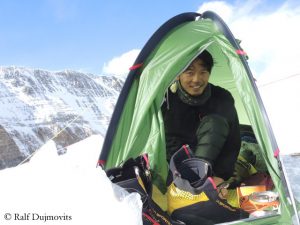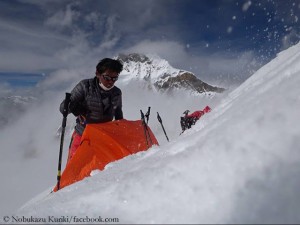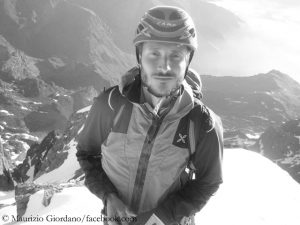Did Nobukazu Kuriki overtighten the screw?
What did Nobukazu Kuriki really intend on Everest? This question has been bothering me ever since the 35-year-old Japanese climber was found dead on 21 May at an altitude of about 6,600 meters. Nobukazu had made a secret of his exact plan in the weeks before. He wanted to climb through the Southwest Fall, his office said after Kuriki’s death. Solo and without bottled oxygen, as he had claimed for himself? If Nobukazu had only fulfilled one of these two conditions, he would have already made Everest history.
Only one Southwest Face success without breathing mask
Since the first ascent by the British Doug Scott and Dougal Haston in fall 1975, only about 30 climbers have successfully climbed the Southwest Face – only once without bottled oxygen: Jozef Just was the only climber of a four-man Slovak team to reach the summit in fall 1988. During the descent he and his three other team mates died. There had never been a serious solo attempt on the steep and dangerous Southwest Face before Kurik’s entry into the wall. The Slovak Vladimir Strba had announced that he would tackled it solo in spring 2017, after he had had to turn back in the wall the year before with his compatriot Zoltan Pal at 7,200 meters. However, Strba then switched to the normal route. The 48-year-old died of high altitude sickness on the South Col after climbing up to the South Summit at 8,750 metres without breathing mask.
How sick was Kuriki really?
Against this background alone, Kuriki’s chances of success had to be rated as extremely low – even if he had been in top form. However the Japanese wasn’t. After arriving at base camp, he suffered from severe cough and fever. Two days before he died, Kuriki said he still had a slight cough, adding that it was almost gone. Kuriki entered the wall and pitched up his tent at 7,400 meters. There he assured by radio that he would be careful. He must have gotten worse at night. The next morning, his team informed that Kuriki was ill and was therefore descending. After that, there was no sign of life from him. Members of the camera crew, who were to film his ascent from the slopes of Nuptse, searched for him and finally found Nobukazu. “Considering condition of his body, it can be assumed that he probably slipped 100 to 200 meters,“ Kuriki’s office said.
Having set the bar even higher than lower
Did Kuriki really believe that he could master the Southwest Face? The Japanese climber Ken Noguchi told the newspaper “Asahi Shimbun” that he doesn’t think so: “It seems to me that at some point, his goal was no longer about stepping foot on the summit but exposing himself to the toughest conditions imaginable and sharing that with people.” Also on his seven previous attempts on Everest, six of them in fall, Kuriki often seemed to overestimate his abilities. In 2012, he suffered severe frostbite during an attempt via the West Ridge. Nine of his ten fingers had to be amputated. Nevertheless, he returned to Everest, first to the normal route on the south side, where he was alone in 2015, then to the North Face, finally to the Southwest Face. Instead of setting the bar lower, Kuriki even increased his ambitions.
Unrealistic goals
“He would have had a good chance of ascent without oxygen if only he had taken the Southeast Ridge (the normal route),” said Yasuhiro Hanatani, a climber and friend of Nobukazu, “but that would have meant not doing it solo.” Obviously Kuriki was also under pressure. A Japanese friend of mine told me that the local media had lost interest in the 35-year-old over time because he always made big plans that realistically did not promise success. Maybe Nobukazu Kuriki finally overtightened the screw – which often ends deadly on the highest mountains on earth.










